After a Minneapolis police officer killed George Floyd last summer, Thiel started digging into what really happened at the Grayson County Courthouse more than nine decades ago. What she uncovered was evidence of an especially terrible Jim Crow-era lynching and the razing of a once-booming Black business district.
Now, Thiel is fighting to install a historical marker outside the courthouse, commemorating what’s today known as the “Sherman riot.” Thiel thinks county leadership wants to keep the past buried, but she believes it’s too important to forget.
“When you think about things in history, sometimes you don’t imagine that they were real people. It’s like it’s a fairytale a long time ago,” she said. “But it was real people that really got hurt."
Thiel’s push for a marker has attracted the attention of those living outside Sherman, a city of some 44,000 people located around 65 miles north of Dallas. The Washington Post published a piece detailing Thiel’s effort earlier this month.
The way Thiel tells it, in 1930, a local Black farmhand named George Hughes had been working for a white married couple. According to certain accounts, Hughes raped the wife sometime after he turned up to collect $6 in back pay.
But some in the community insisted their relationship was consensual. Others also posited that the couple fabricated the story about the assault to avoid paying Hughes.
Whatever the case, Hughes was soon arrested and taken to the Grayson County Courthouse in Sherman for trial. A confession was reportedly obtained, the details of which Thiel said are murky.
Many wanted Hughes to be sentenced to death, but on the day of his trial, a mob of some 5,000 people became his de facto executioner.
The bloodthirsty horde effectively overpowered the Texas Rangers stationed at the scene, and someone lit the courthouse aflame. Officials rushed Hughes to a fireproof vault for safekeeping. Soon, though, the fire had spread out of control.
Many believe Hughes died of asphyxiation, but Thiel said one person reported the farmhand was still breathing after the vault was burst open and he was tied to the back of a car.
Hughes was dragged a few blocks to Mulberry Street, home of the town's thriving Black business district. There, the mob hung his body from a tree, castrated it and set it on fire.
Then, they burned the business district down, resulting in the loss of generations of Black wealth. Today, it is a parking lot, according to The Post.
For two weeks, Sherman was under martial law and the National Guard was called in to prevent further chaos. Thiel said the Sherman riot made national news at the time, twice landing on the front page of The New York Times.
“You can’t heal from something you don’t acknowledge." – Melissa Thiel, public historian
tweet this
There’s no such thing as a “good lynching,” but this one was particularly egregious, said Todd Moye, a history professor at the University of North Texas. It's also reminiscent of what happened during the 1921 Tulsa race massacre, during which a white mob destroyed Black homes and storefronts.
The drive for a Sherman historical marker also comes at a time when racial tensions are simmering nationwide.
Confederate monuments continue to be removed on the heels of last summer’s wave of Black Lives Matter protests. And conservative lawmakers are fixated on banning Critical Race Theory, a drive that many educators say will make it harder to teach about racism.
Ignoring topics that make white people uncomfortable is “very much in vogue these days,” Moye said. That’s especially the case in Texas.
Signed into law by Gov. Greg Abbott, Moye said House Bill 3979 will require Texas educators to teach “both sides” of conflicts like the Sherman riot. Moye sees the law as part of a broader offensive, wherein white people engage in “backlash against Black Lives Matter.”
When Thiel began calling for a historical marker last June, she had no idea she’d be met with such pushback. She said she'd already gained approval from the Grayson County Historical Commission, and even got assurances from the state’s historic preservation agency that they’d greenlight the marker.
But first, Grayson County Judge Bill Magers and the county commissioners have to sign off on the project, and that is where it has ground to a halt. Every week, Thiel asks county officials to place the issue on the Tuesday weekly agenda.
“They don’t want to acknowledge it,” she said. “And they won’t give us an answer why.”
Magers and the Grayson County Commissioners did not return the Observer's requests for comment by publication time.
Leadership may be counting on the effort to lose steam, but Thiel will continue the charge to install a historical marker. The way she sees it, mending can’t occur if the community doesn’t recognize its history — warts and all.
“I think it will happen eventually. I don’t know if it’ll be from my efforts and the people working with me or if it’s going to be 50 years from now, but I think it’s going to happen at some point,” Thiel said.
“You can’t heal from something you don’t acknowledge,” she continued, “and I think it’s just so important for us to be able to heal and move forward.”













